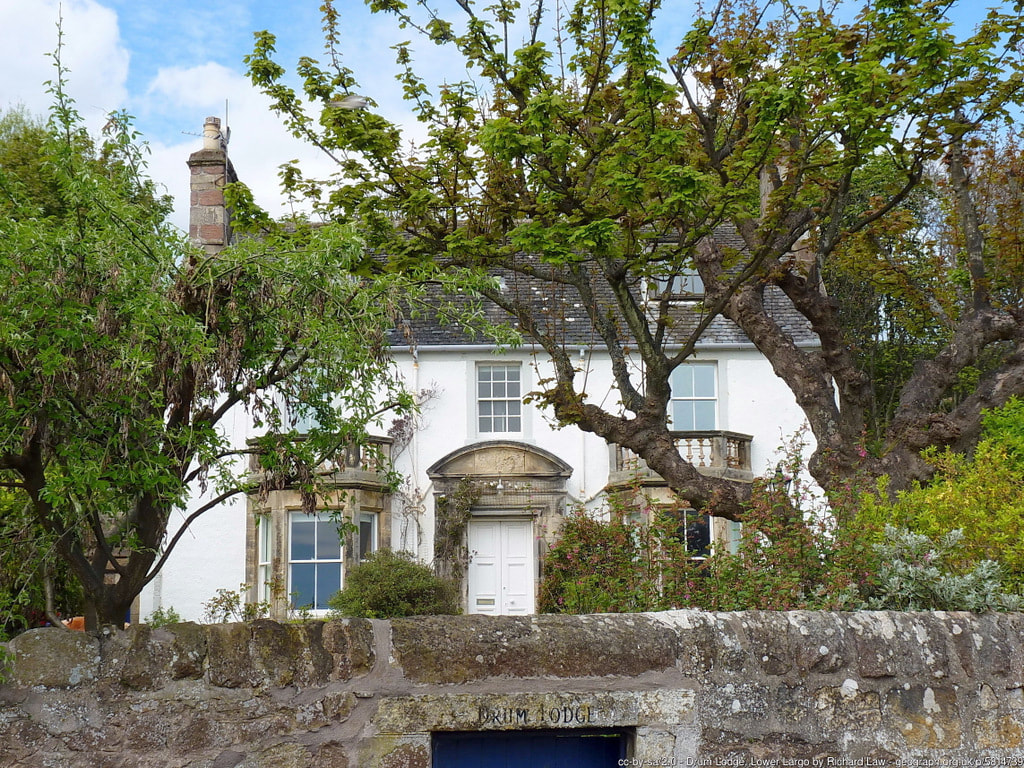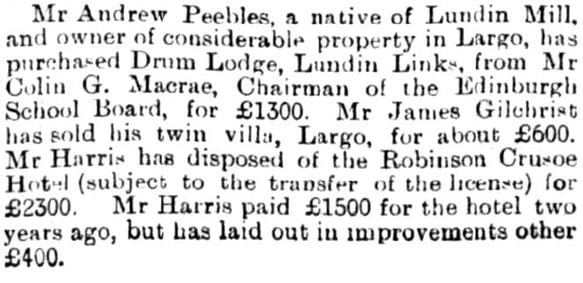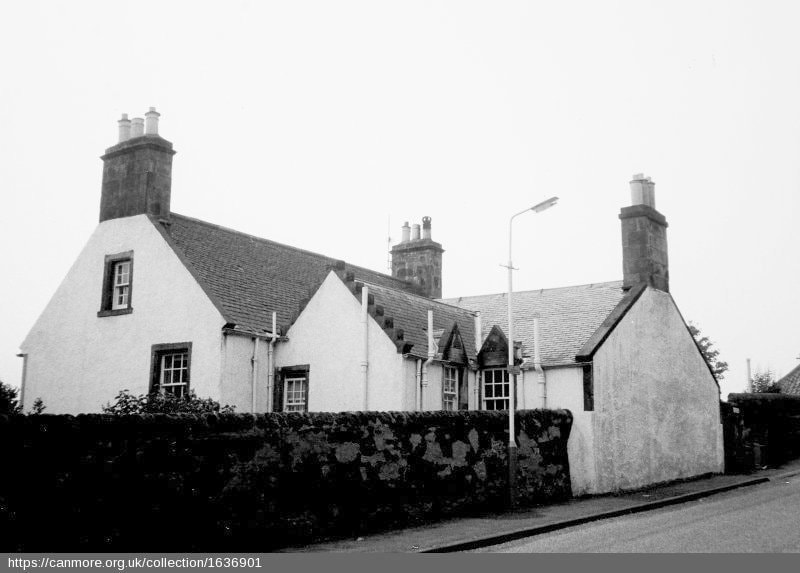Late 18th/early 19th century, 2 storeys and attic 3 bays with late 19th century rear wing and alterations to south front. Harled mainly with painted margins. South front ground floor alterations comprise central door in moulded and segmentally pedimented doorpiece, flanked by canted windows with balustrades. Some 12-pane glazing remains. Straight skews, end stacks, slate roof. Rear wing with gabled dormerheads.
Unsurprisingly, the origins of Drum Lodge are linked to the adjacent former salt pans at Drummochy. Salt works overseer and factor to the Earl of Leven, Ebenezer Coutts, was the building's first occupant. It was probably built in the late 1700s and its original name was 'Drummochie House' (see 1850s map below). It was suitably positioned between the salt pan house (later a joiner's workshop) to the west and the salt girnel (later known as the Net House) to the east by the harbour.
In addition to the handy location, the house's extensive view of Largo Bay would have proved useful to the first occupant Ebenezer Coutts in his wide-ranging role as factor to the Earl of Leven (more on that in the next post). Coutts died in 1822 and, for a spell after that, Cupar-born George Miller seems to have occupied the house. In 1856 'Drummochy House' was put up for sale (see advert below from 13 March Fife Herald). Note the 'well-stocked garden' and the 'Park of Land' that would later become Drum Park.
John Anthony Macrae bought the house and it soon became known as 'Drum Lodge'. Macrae was a Writer to the Signet (solicitor) based in Edinburgh. He had an interesting background - more of which another time. The house was likely used as a summer residence. Macrae had got to know Fife in his student days at St Andrews University. The imminent opening of the railway line would have been another factor in his purchase. Note also the mention of the house's outbuildings in the advert below - the gig-house, stable and barn. These 'offices' are shown in the image further below, prior to their conversion into a dwelling a few years after this black and white photo was taken in 1975.
Peebles had bought the property as an investment. As he was still working at the Duke of Northumberland's Albury estate, he rented Drum Lodge out. Around 1902 to 1904 the Paxton family (later of Homelands) lived at Drum Lodge. Their two middle daughters of four were born at Drum Lodge: Margaret Baird Paxton on 17 February 1902 and Isabella Carse Paxton on 22 June 1904. The Paxtons then moved to Elphinstone on Crescent Road in 1905 before purchasing Homelands in 1908. In 1908 at Drum Lodge the extensive grounds were developed, when Walter Horne erected two terraces of houses at Drum Lodge - known originally as 'Drum Lodge Park', it is now simply 'Drum Park'.
The next tenant was Mrs Isabel Anstruther Thomson, widow of Colonel John Anstruther Thomson of Charleton and Carntyne (who had died in 1904). She was at Drum Lodge through the 1910s with her daughter Rachel until her death in 1918. Proprietor Andrew Peebles had died in 1912 and so Drum Lodge ownership had passed to his widow Phoebe. She continued to own and rent out the house. Miss Rachel Anstruther Thomson was tenant until 1923 when she married Michael Willoughby Gordon-Cumming and settled in Crail.
Around 1924 William Kidd Ogilvy Shepherd purchased Drum Lodge from Phoebe Peebles. He was a solicitor based in Leven - a partner in the firm of W. & J. Ogilvy Shepherd. Among his many roles and interests, he was for many years Secretary of Lundin Golf Club. He was also a founder of Leven Rotary Club and a leading member of the Lundin Amateur Dramatic Society. When he died in 1941, aged 52, Mrs Shepherd remained at Drum Lodge. However, in 1951 the house was up for sale once again (see advert below from 4 September Dundee Courier). Note how by this time the house had been 'completely modernised' boasting such features as a 'heated towel rail'. The garden remained 'exceptionally well-stocked' and had a 'heated greenhouse'. The house began a new chapter and its story continues to this day, more than two centuries after it all began.








 RSS Feed
RSS Feed
